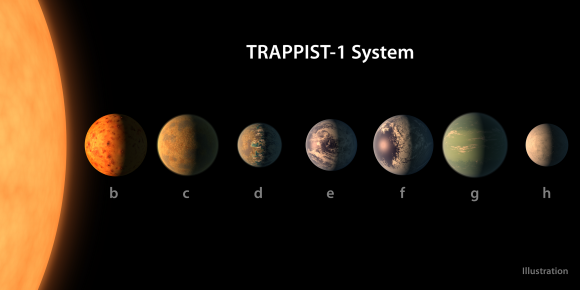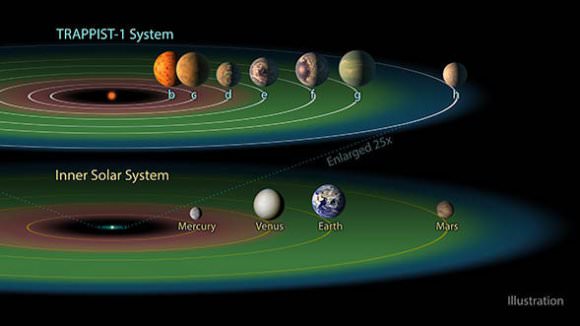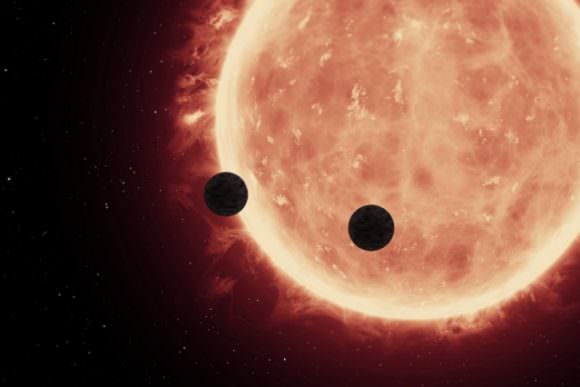Ever since scientists confirmed the existence of seven terrestrial planets orbiting TRAPPIST-1, this system has been a focal point of interest for astronomers. Given its proximity to Earth (just 39.5 light-years light-years away), and the fact that three of its planets orbit within the star's "Goldilocks Zone", this system has been an ideal location for learning more about the potential habitability of red dwarf stars systems.
This is especially important since the majority of stars in our galaxy are red dwarfs (aka. M-type dwarf stars). Unfortunately, not all of the research has been reassuring. For example, two recent studies performed by two separate teams from Harvard-Smithsonian Center for Astrophysics (CfA) indicate that the odds finding life in this system are less likely than generally thought.
The first study, titled "Physical Constraints on the Likelihood of Life on Exoplanets", sought to address how radiation and stellar wind would affect any planets located within TRAPPIST-1s habitable zone. Towards this end, the study's authors - Professors Manasvi Lingam and Avi Loeb - constructed a model that considered how certain factors would affect conditions on the surface of these planets.

This artist's concept shows what each of the TRAPPIST-1 planets may look like, based on available data about their sizes, masses and orbital distances. Credits: NASA/JPL-Caltech
This model took into account how the planets distance from their star would affect surface temperatures and atmospheric loss, and how this might affect the changes life would have to emerge over time. As Dr. Loeb told Universe Today via email:
"We considered the erosion of the atmosphere of the planets due to the stellar wind and the role of temperature on ecological and evolutionary processes. The habitable zone around the faint dwarf star TRAPPIST-1 is several tens of times closer in than for the Sun, hence the pressure of the stellar wind is several orders of magnitude higher than on Earth. Since life as we know it requires liquid water and liquid water requires an atmosphere, it is less likely that life exists around TRAPPIST-1 than in the solar system."
Essentially, Dr. Lingam and Dr, Loeb found that planets in the TRAPPIST-1 system would be barraged by UV radiation with an intensity far greater than that experienced by Earth. This is a well-known hazard when it comes to red dwarf stars, which are variable and unstable when compared to our own Sun. They concluded that compared to Earth, the chances of complex life existing on planets within TRAPPIST-1's habitable zone were less than 1%.
"We showed that Earth-sized exoplanets in the habitable zone around M-dwarfs display much lower prospects of being habitable relative to Earth, owing to the higher incident ultraviolet fluxes and closer distances to the host star," said Loeb. "This applies to the recently discovered exoplanets in the vicinity of the Sun, Proxima b (the nearest star four light years away) and TRAPPIST-1 (ten times farther), which we find to be several orders of magnitude smaller than that of Earth."

Three of the TRAPPIST-1 planets – TRAPPIST-1e, f and g – dwell in their star's so-called "habitable zone. CreditL NASA/JPL
The second study - "The Threatening Environment of the TRAPPIST-1 Planets", which was recently published in The Astrophysical Journal Letters - was produced by a team from the CfA and the Lowell Center for Space Science and Technology at the University of Massachusetts. Led by Dr. Cecilia Garraffo of the CfA, the team considered another potential threat to life in this system.
Essentially, the team found that TRAPPIST-1, like our Sun, sends streams of charged particles outwards into space - i.e. stellar wind. Within the Solar System, this wind exerts force on the planets and can have the effect of stripping away their atmospheres. Whereas Earth's atmosphere is protected by its magnetic field, planets like Mars are not - hence why it lost the majority of its atmosphere to space over the course of hundreds of million of years.
As the research team found, when it comes to TRAPPIST-1, this stream exerts a force on its planets that is between 1,000 to 100,000 times greater than what Earth experiences from solar wind. Furthermore, they argue that TRAPPIST-1's magnetic field is likely connected to the magnetic fields of the planets that orbit around it, which would allow particles from the star to directly flow onto the planet's atmosphere.

Illustration showing the possible surface of TRAPPIST-1f, one of the newly discovered planets in the TRAPPIST-1 system. Credits: NASA/JPL-Caltech
In other words, if TRAPPIST-1's planets do have magnetic fields, they will not afford them any protection. So if the flow of charged particles is strong enough, it could strip these planets' atmospheres away, thus rendering them uninhabitable. As Garraffo put it:
"The Earth's magnetic field acts like a shield against the potentially damaging effects of the solar wind. If Earth were much closer to the Sun and subjected to the onslaught of particles like the TRAPPIST-1 star delivers, our planetary shield would fail pretty quickly."
As you can imagine, this is not exactly good news for those who were hoping that the TRAPPIST-1 system would hold the first evidence of life beyond our Solar System. Between the fact that its planets orbit a star that emits varying degrees of intense radiation, and the proximity its seven planets have to the star itself, the odds of life emerging on any planet within it's "habitable zone" are not significant.
The findings of the second study are particularly significant in light of other recent studies. In the past, Prof. Loeb and a team from the University of Chicago have both addressed the possibility that the TRAPPIST-1 system's seven planets - which are relatively close together - are well-suited to lithopanspermia. In short, they determined that given their close proximity to each other, bacteria could be transferred from one planet to the next via asteroids.

An artist's depiction of planets transiting a red dwarf star in the TRAPPIST-1 System. Credit: NASA/ESA/STScl
But if the proximity of these planets also means that they are unlikely to retain their atmospheres in the face of stellar wind, the likelihood of lithopanspermia may be a moot point. However, before anyone gets to thinking that this is bad news as far as the hunt for life goes, it is important to note that this study does not rule out the possibility of life emerging in all red dwarf star systems.
As Dr. Jeremy Drake - a senior astrophysicist from the CfA and one of Garraffo's co-authors - indicated, the results of their study simply mean that we need to cast a wide net when searching for life in the Universe. "We're definitely not saying people should give up searching for life around red dwarf stars," he said. "But our work and the work of our colleagues shows we should also target as many stars as possible that are more like the Sun."
And as Dr. Leob himself has indicated in the past, red dwarf stars are still the most statistically-likely place to find habitable worlds:
"By surveying the habitability of the Universe throughout cosmic history from the birth of the first stars 30 million years after the Big Bang to the death of the last stars in 10 trillion years, one reaches the conclusion that unless habitability around low-mass stars is suppressed, life is most likely to exist near red dwarf stars like Proxima Centauri or TRAPPIST-1 trillions of years from now."
If there is one takeaway from these studies, it is that the existence of life within a star system does not simply require planets orbiting within the circumstellar habitable zones. The nature of the stars themselves and the role played by solar wind and magnetic fields also have to be taken into account, since they can mean the difference between a life-bearing planet and a sterile ball of rock!
Further Reading: CfA, International Journal of Astrobiology, The Astrophysical Journal Letters.
No comments:
Post a Comment